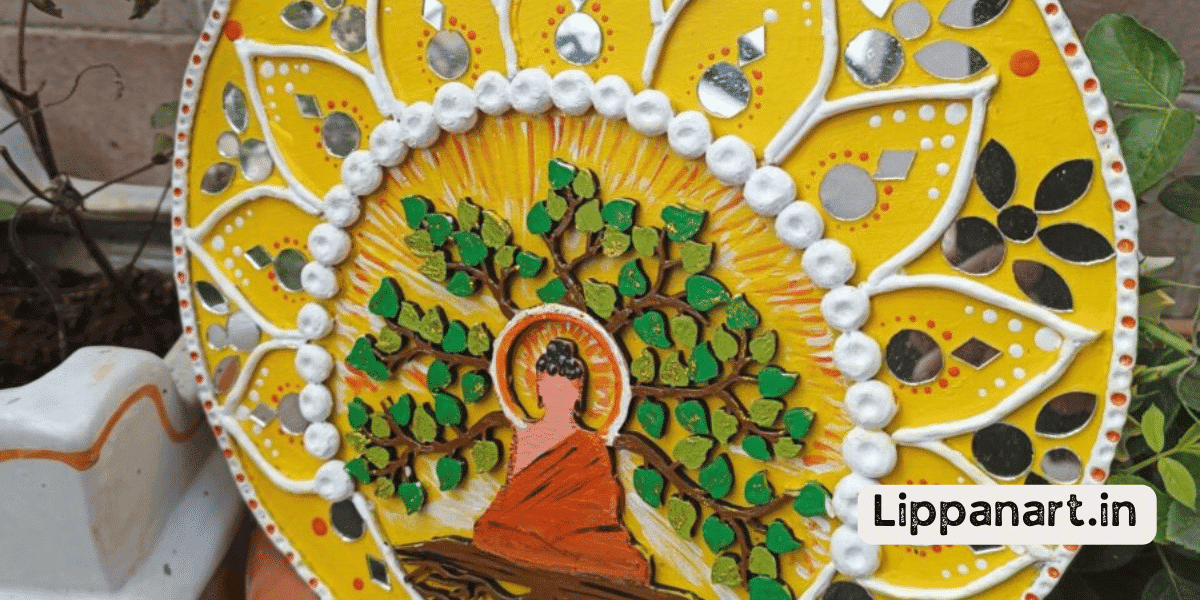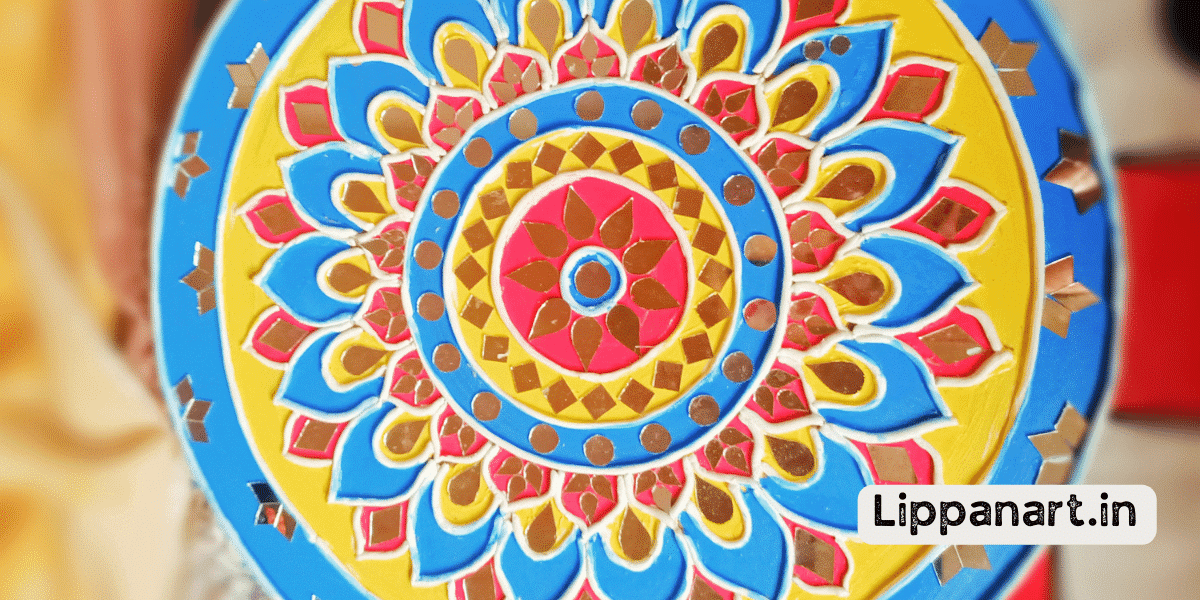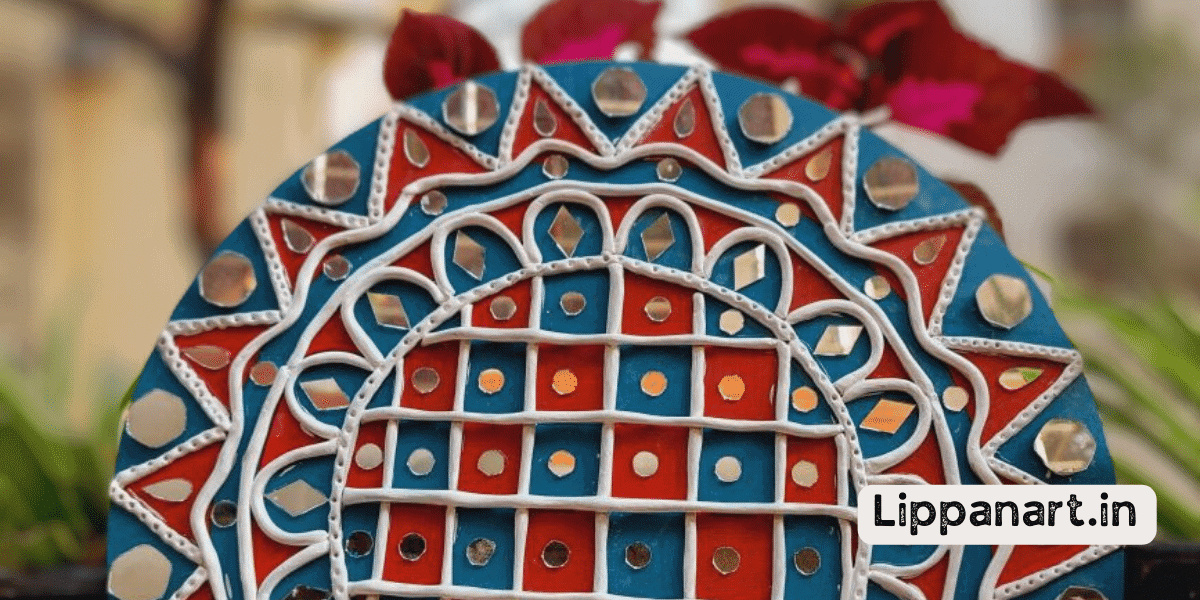Create captivating art with a centuries-old technique! Crafting your own lippan mud is easy and fun.
You can transform ordinary clay into a dazzlingly expressive medium with just a few natural ingredients and a little effort. Discover the secrets to finding the perfect clay, mixing the perfect consistency, blending the right textures, and adding the perfect finishing touches to make your mud masterpiece come alive!
Key Takeaways
- Choose the right type of clay for Lippan art and consider the colour selection.
- Take additional sealing steps to protect the design and consider drying time.
- Determine the type of tools needed for working with the clay and mix your own clay or buy pre-mixed clay.
- Use blendings and texturing techniques, such as colouring techniques and surface design options, and experiment with different amounts of straw for desired effects.

Source Clay
To source clay for your Lippan art, you’ll need to find the right type of clay. You can use various shaping techniques with the right clay to create stunning, intricate designs.
When selecting your clay, consider the colour selection that will make your art truly unique. Depending on the type of clay you choose, you may also need to take additional sealing steps to protect your design from fading or cracking over time.
Additionally, consider the drying time required with each clay type and the type of tools you may need to use.
With the right source of clay, you can create beautiful pieces of Lippan art with ease.
Mix Consistency
Mixing the clay to the right consistency is key to creating beautiful Lippan art – so you’ll need to learn how. You can mix your own clay using additives, or you can buy it pre-mixed. Once you have the clay, you can use various mixing tools, like a wooden spoon, mortar and pestle, and a blender, to create the right consistency. You may need to add a little water or other additives to get the desired results.
- Editor’s Choice
- Best Seller
- Amazon Choice
Once you’ve achieved the right consistency, you can begin the sun-drying process. Place the clay on a flat surface and allow it to dry for about an hour. Then, you can shape it using techniques like rolling, cutting, and pinching. Be sure to flip the clay over every so often to help the drying process.
Mixing the right consistency is essential for creating beautiful Lippan art with just a few simple tools and techniques. The end result will last for years. So make sure you take the time to learn the basics of mixing clay, and you’ll be on your way to becoming a master of Lippan art.
Texture Blend
You can blend different textures to create unique and interesting effects for your Lippan art. The key to successful texture blending is to understand the different colouring techniques, surface design, drying methods, tool selection, and sealing processes available to you.
To get started, consider the type of mud you will use and whether you will use pigmentation or natural materials to provide colour. Then, think about the different textured tools you can use to imprint patterns into the mud. From there, you need to plan your drying methods.
Table:
| Colouring Techniques | Surface Design | Drying Methods |
|---|---|---|
| Pigmentation | Imprint Tools | Air-Drying |
| Natural Materials | Sun-Drying | |
| Kiln-Drying |
Add Straw
Adding straw to your mud mixture can help create unique texture and depth to your Lippan art. By adding a bit of straw, you can introduce a range of colours to your art as well as create interesting shape variations. You can then apply your designs and choose from various drying techniques to bring your art to life.
To ensure your art has a longer life, you should use a seal coating to protect it from the elements. Through simple adjustments, adding straw to your mud mixture can help create art pieces full of life and movement.
Whether you’re a beginner or a professional, adding straw to your mud mixture can be an easy way to boost the appearance of your art. Experiment with different amounts and techniques to find out what works best for you, and you’ll soon be creating pieces of art that will be admired for years to come.
Moisten Mixture
Moistening your mud mixture is essential to create the perfect texture for your Lippan art. It requires a careful balance between adding water and allowing the mixture to temper its colours and form the shapes you desire.
Here’s how you can moisten your mud mixture:
- Adding Water:
- To achieve the desired consistency, stir the mixture while gradually pouring in water.
- Check the consistency of the mixture often and adjust the water accordingly.
Forming Shapes:
- Once the mixture has the right consistency, use your hands to shape it into the desired form.
- Take care to distribute the mixture and create the desired shape evenly.
Tempering Colors:
- Let the mixture sit for a few minutes before applying the designs to ensure the colours are properly tempered.
- Please note that the amount of time required for the curing process may differ depending on the level of temperature and humidity in the surrounding environment.
Moistening your mud mixture is an integral part of creating beautiful Lippan art. With the right amount of water, your mixture will achieve a perfect texture, allowing you to form shapes and apply designs that will last for a long time.
Knead Thoroughly
Once you’ve added water and formed shapes, knead the mixture thoroughly to ensure you get the right consistency. Kneading mud for lippan art helps form a homogenous structure to create beautiful, lasting designs.
When adding colours, knead them into the mud to ensure they blend well and are evenly distributed. The mud can become more pliable and easier to work with as you knead.
During drying, it’s important to knead the mud regularly to prevent cracking. Kneading the mud will also ensure the pieces are more durable and last longer.
- Editor’s Choice
- Best Seller
- Amazon Choice
Finally, when storing the mud, knead it properly before packing it away to ensure the pieces are secure.
Regarding safety precautions, follow proper hygiene and sanitation guidelines when kneading the mud.
With these tips and techniques, you can have the confidence to create stunning lippan art with durable, lasting results.
Ready for Use
Once you’ve kneaded the mixture, it’s ready for use! With the mud prepared, it’s time to start creating your lippan art. This traditional Indian art is a visually appealing and environment-friendly form of expression.
Here are a few tips to help you ensure quality maintenance, cost-effectiveness, and time-saving:
Quality Maintenance
- Keep the clay moist and pliable
- Test the clay and make sure it adheres to the wall
- Use a clean cloth to apply the clay
Cost Effective
- Reuse the clay when possible
- Use natural pigments for the colour
- Use low-cost materials for the tools
Time-Saving
- Plan the design in advance
- Work in sections and let each section dry before continuing
- Use tools that are easy to handle and clean up quickly
Conclusion
With just a few simple steps, you’re ready to start creating beautiful lippan art!
Knead the mud thoroughly and moisturize it to the right consistency.
As they say, practice makes perfect, so get creative and have fun!
With time and patience, you’ll be an artistic master of lippan art in no time.




















